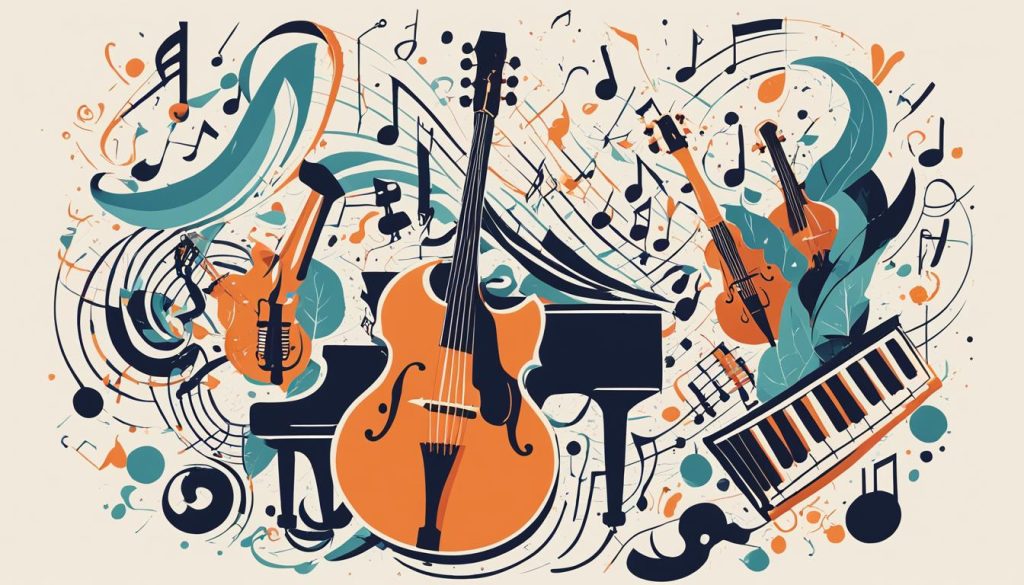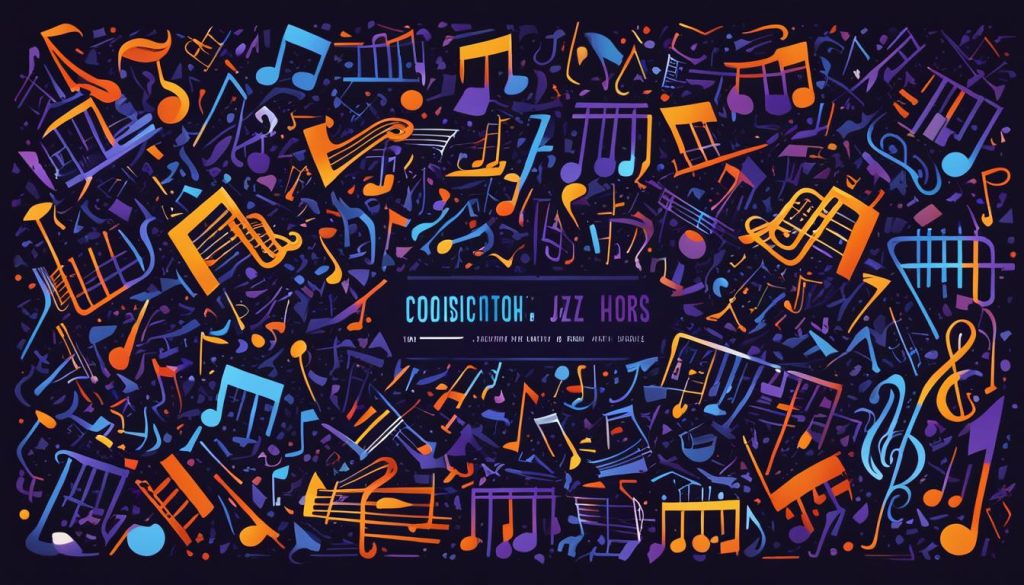Master Jazz Chords – Elevate Your Music Play
Jazz music is known for its complex harmonies and soulful melodies. To truly capture the essence of this genre, mastering jazz chords is crucial. By understanding the intricacies of jazz chords, musicians can enhance their musicality and create rich progressions in their compositions and improvisations.
In this section, we will explore the fundamentals of jazz chords, including voicings and extensions. We’ll also discuss the importance of chord progressions in jazz music and how to incorporate them into your playing.
Key Takeaways
- Mastering jazz chords can enhance your musicality.
- Voicings and extensions add complexity and richness to jazz compositions.
- Understanding chord progressions is crucial in jazz music.
- Jazz chords can be incorporated into improvisations for soulful progressions.
- By embracing the world of jazz chords, musicians can elevate their music play to new heights.
Unleashing the Power of Jazz Chords
Exploring the world of jazz chords can open up new avenues for musicians to enhance the richness and complexity of their compositions. Jazz chords are known for their distinct character, and with the right voicings and extensions, they can make a tremendous impact on the overall sound.
Voicings are different ways of arranging the notes in a chord, creating various textures and colors. Extensions are extra notes added to a chord to create more complex harmonies. Jazz chords often use extensions, such as the ninth, eleventh, and thirteenth, to add more depth to the sound.
Learning how to incorporate these chords into your improvisations and compositions can be an exciting and rewarding experience. Experimenting with different voicings and extensions can enhance your musicality and help you develop your signature sound.
“Jazz is a music that celebrates life and human emotions in all their complexities.” – Herbie Hancock
The Power of Jazz Chord Voicings
Voicings can drastically change the sound of a chord progression. Using different inversion and placement of notes can give a chord progression a completely different feel. The table below illustrates some common voicings for a C7 chord:
Exploring Jazz Chord Extensions
Extensions are a critical part of jazz chords. They add nuances and depth to the sound, making the harmony more complex and sophisticated. The table below illustrates some common extensions for a dominant 7th chord:

Adding extensions can be a simple way to turn a basic chord into a more complex and interesting one. Experimenting with these different extensions is key to discovering new sounds and creating unique harmonies.
By understanding jazz chord voicings and extensions, musicians can unlock a world of possibilities for their music compositions. Learning how to incorporate these chords into your musical repertoire can help you elevate your musicality and take your playing to the next level.
Essential Jazz Chord Progressions
One of the hallmarks of jazz music is its chord progressions. Jazz musicians often use complex chord progressions to create rich and intricate harmonies. While there are many different chord progressions used in jazz music, some are considered essential and are used frequently in jazz compositions and improvisations.
The ii-V-I Progression
Perhaps the most famous and widely used jazz progression is the ii-V-I. This progression appears in countless jazz standards and is an essential tool for any jazz musician. The ii-V-I progression consists of three chords: the ii chord, the V chord, and the I chord. The ii chord is typically a minor 7th chord, the V chord is a dominant 7th chord, and the I chord is a major 7th chord. For example, in the key of C, the ii-V-I progression would be Dm7-G7-Cmaj7.
The ii-V-I progression is often used as a turnaround, meaning it is played at the end of a section to lead back to the beginning. It is also commonly used as the main progression for a tune or as a section of a tune.
Other Essential Progressions
Aside from the ii-V-I progression, there are several other chord progressions that are considered essential in jazz music. These include:
- The iii-vi-ii-V progression
- The I-vi-ii-V progression
- The turnaround progression
These progressions are useful for creating variety in your compositions and improvisations. It’s essential to learn these progressions in different keys and contexts to expand your musical palette.

“Jazz is not just ‘Well, man, this is what I feel like playing’. It’s a very structured thing that comes down from a tradition and requires a lot of thought and study.”
– Wynton Marsalis
Jazz Chord Substitutions and Reharmonization
Mastering jazz chords is not only about memorizing different chords and voicings but also about exploring chord substitutions and reharmonization techniques that can take your music to new heights. Instead of sticking to the standard progressions, chord substitutions allow you to substitute a chord with another chord that adds a unique twist to the harmonic progression, creating interesting variations and harmonic interest in your music.
Reharmonization, on the other hand, refers to changing the harmonic structure of a song, while retaining the original melody. It involves replacing existing chords with new ones, transforming the song’s sound completely. This technique can be used to add complexity and interest to simple melodies, making them sound more sophisticated.
Chord substitution and reharmonization techniques are widely used in jazz and are essential tools for jazz musicians to create unique and dynamic compositions. By mastering these techniques, you can add a new dimension to your music and stand out as a creative and sophisticated musician.
“You cannot play a blues in a room full of squares, it comes out as jazz” – Cannonball Adderley
Conclusion
Mastering jazz chords can be a game-changer for musicians who want to take their music to new heights. By incorporating jazz chords into their compositions and improvisations, musicians can create soulful progressions and intricate harmonies that elevate their musicality.
Throughout this article, we explored the intricacies of jazz chords, including different voicings, extensions, and substitutions. We also discussed essential jazz chord progressions, such as the famous ii-V-I, and how to apply them in different keys and contexts.
By embracing these techniques and tips, musicians can infuse their music play with richness, complexity, and uniqueness. Whether you’re a seasoned jazz musician or a beginner, mastering jazz chords can help you express yourself in new and exciting ways.
So take the time to practice and explore the world of jazz chords. With dedication and persistence, you can unleash the power of these chords and create music that speaks to the soul.
FAQ
What are jazz chords?
Jazz chords are a set of complex and sophisticated chords commonly used in jazz music. They are known for their rich and vibrant sound, and they add an element of sophistication and complexity to compositions and improvisations.
How can mastering jazz chords enhance my musicality?
Mastering jazz chords can greatly enhance your musicality by providing you with a deeper understanding of harmony and chord progressions. It allows you to explore different tonal colors, create soulful progressions, and add complexity and richness to your music.
What are jazz chord voicings and extensions?
Jazz chord voicings refer to the different ways a chord can be played in a specific arrangement or order of its notes. Extensions are additional notes added to a chord to create more harmonic possibilities. Understanding and incorporating various voicings and extensions can add depth and complexity to your chord progressions.
What are some essential jazz chord progressions?
Some essential jazz chord progressions include the famous ii-V-I progression, which is commonly used in jazz music. Other common progressions include the blues progression and the circle of fifths progression. These progressions serve as the foundation for many jazz tunes and provide a framework for improvisation.
How can I apply jazz chord progressions in different keys and contexts?
To apply jazz chord progressions in different keys and contexts, it’s important to understand the relationships between chords and their function within a progression. Transposing progressions to different keys and experimenting with different rhythmic and melodic variations can help you expand your musical palette and improvisational skills.
What are jazz chord substitutions and reharmonization techniques?
Jazz chord substitutions involve replacing a chord or a set of chords within a progression with alternative chords that share similar harmonic functions. Reharmonization techniques take this concept further by completely reharmonizing a melody or a progression to create new and unique harmonic possibilities. These techniques add interest and variety to your music.
How can jazz chord substitutions and reharmonization techniques add flair to my music?
Jazz chord substitutions and reharmonization techniques allow you to add a unique and personal touch to your music. By replacing chords within a progression or reharmonizing a melody, you can create unexpected harmonies, explore different tonalities, and add a fresh and exciting sound to your compositions and improvisations.
